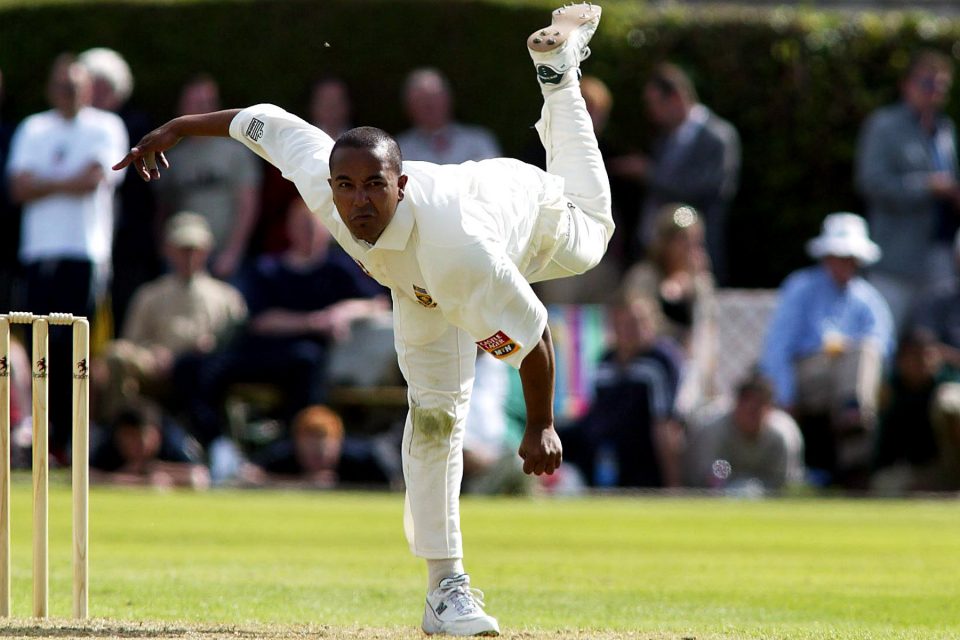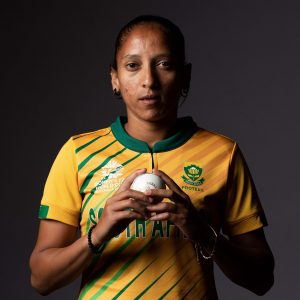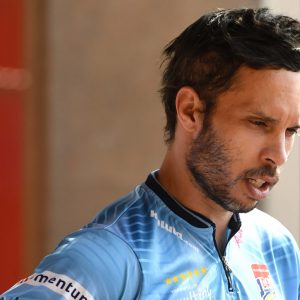Paul Adams: South African cricket’s quirky outlier
Gogga’s life as a Protea and then as coach of the Cobras started like a wild flame but ended in a whimper, with an injury and a player-mutiny his downfall. But he looks back with pride.
Author:
17 June 2020

On a dusty street in Mamre north of Cape Town at 7pm, a cricket match explodes into being. Young boys are hastily assigned roles as two wooden crates are planted in place of wickets. The field is set.
A crowd has already gathered by the time a barefoot batter wearing a well-worn wide-brim takes guard. A lithe and shirtless bowler charges in, his spindly arms a blur, his cheeks streaked with paint like a berserker from a forgotten age.
This game captured the imagination of South African cricket fans in 1998 though it never happened. Not really. Instead, it was an advert promoting Standard Bank’s once unblemished relationship with the game. The protagonists may have been actors but their youthful exuberance encapsulated a nation still governed by Nelson Mandela and believing in his rainbow-tinted vision of the future.
Like all children, those on the screen were pretending to be someone else. The aggressive batter was Hansie Cronje. The snarling quick was Allan Donald. Another child tosses a ball between his hands, cocks an eyebrow and proclaims, “I’m Paul Adams.”
He didn’t need to tell us. Seconds later he sidles up to the stumps, contorts his body and delivers the ball in an unmistakable manner. No one in the history of this ancient game has bowled with such an instantly recognisable action as Paul Regan Adams. Furthermore, few have had as much of an impact on a nation’s psyche while doing so.
Adams entered South Africa’s cricket consciousness like a bolt from the heavens. In the space of just three weeks in late 1995, he went from a little known 18-year-old still carrying some puppy fat to the youngest ever Protea when he debuted against England in Port Elizabeth in just his sixth first-class game.
It wasn’t just his age and inexperience that garnered so much attention. He was what the apartheid government classified as coloured, representing a country that only a few years before had deemed the colour of his skin a crime. He bowled attacking wrist spin with his left hand, an anomaly in a country stacked with snarling pace bowlers and conservative slow-men. And then of course, there was his action.
“It’s unique,” Adams tells New Frame from his home in Cape Town. “It was just something that developed naturally. I picked up a ball and it just happened. We were self taught back then. Maybe if I grew up somewhere else I might have turned out differently.”
Adams was raised in Grassy Park on the Cape Flats. The son of a fisherman, his athletic abilities were honed in an intense furnace fuelled by two older brothers. “There was no mercy,” he says. “If I wanted a chance to bat I had to figure out a way of getting them out.”
A boy squaring off with men
The young spinner with the “frog in a blender” action, a description coined by former England captain Mike Gatting, grew accustomed to sharing a field with older players. Free from the meticulous curation of elite school-boy coaching, his individuality blossomed at club cricket.
He routinely squared up against men twice his age, first with Blue Bells Cricket Club and then starring for Basil D’Oliveira’s alma mater St Augustine’s. The details of his birth certificate were irrelevant. All that mattered was the collection of bamboozled batters he left in his wake.
Sensing an approaching glass ceiling, Adams transferred to Plumstead High School as a 15-year-old in 1992 in search of better opportunities. Three years later, as part of the Western Province academy, he was invited to bowl to the association’s senior team where Proteas all-rounder Brian McMillan bestowed upon him the nickname “Gogga”, meaning insect in Afrikaans.
Related article:
His rise was exponential. He turned out once for Western Province’s B team before debuting for Eric Simons’ first XI against Northern Transvaal. On live television he spun his side to victory with a second innings six-wicket haul on 7 November 1995.
That was enough for a call-up to the South Africa A team to help to tune-up the touring English. In a famous six-wicket win that included a ton from Adam Bacher and all-round contributions from Jacques Kallis and Lance Klusener, Adams claimed four in England’s first dig and five in their second. He removed middle-order stalwart Graeme Thorpe in both innings for a grand total of four.
Adams became an overnight sensation. The cricket world had never seen anything like him. Naturally, the media’s spotlight burned bright.
Related article:
“I was terrified,” Adams says about facing up to the press at the time. “I was a kid, it was daunting. I’d never experienced anything like that. I was very much a one-word answer man.”
He let the ball do the talking. Against a star-studded Border he collected another six wickets including those of Cronje and Darryll Cullinan. With Clive Eksteen going wicketless over 52 second-innings overs in the drawn Test against England at the Wanderers, calls for an attacking spinner grew to a crescendo.
“There were pictures of me in every newspaper,” Adams says. “I didn’t feel too much pressure. I was just focused on taking wickets for Western Province. But I got the call that I would be taking part in the Boxing Day Test in Port Elizabeth. Hansie told me personally that I’d be representing my country.”
Influential figure in SA cricket
For the next five years, on beaches and streets, in parks and private gardens, children twisted their bodies in imitation of a young man who had become an icon. Mandela himself would invite the chubby-cheeked Adams to his home in Bishopscourt, reminding the rising star of sport’s power to change the world and his own standing in his nation’s narrative.
“I didn’t quite appreciate it at first, but I realised I made an impact,” Adams says. “It was a driver for me. I spoke a lot about this with other sportsmen of colour. Guys like Breyton Paulse and Makhaya Ntini. It was so important for us to perform. I always felt that responsibility.”

By the time England were next in town, Adams had taken 83 wickets from 26 Tests in seven countries. He was on course to join a pantheon of great wrist spinners of the era such as Shane Warne, Anil Kumble and Mushtaq Ahmed. He would never reach those heights.
In the final Test against England in Centurion, in which Cronje had orchestrated a contest from a rain-affected match in exchange for money, Adams collided with an advertising board near the boundary. His bowling hand got stuck at an awkward angle and his middle finger dislocated.
While his teammates were on tour to India later that year, Adams learned to bowl with a new grip. He had sustained nerve damage in the accident and his fingers snapped with a different feel.
He returned to a transformed organisation. Cronje confessed to match-fixing and Shaun Pollock was given the captaincy. Adams took three expensive wickets in his comeback match which ended in an innings defeat to Sri Lanka in Galle.
Related article:
Adams would play just 15 more Tests and 11 one-day internationals (ODIs) over the next four years. There were highlights – 10 wickets in a match against Bangladesh in Chittagong and a career best 7/128 in defeat to Pakistan in Lahore – but the numbers point to a decline. Before his injury, he averaged under 30 with the ball. Afterwards that number climbed above 40.
There were other mitigating factors. Under Cronje, Adams was used as an attacking weapon. It is telling that he never bowled in tandem with Donald and was given licence to take wickets no matter the cost. New captain Graeme Smith had different expectations and required a more defensive spinner in his ranks.
Adams donned the Protea for the last time as a 27-year-old in March 2004. He claims he was still in “peak form”. The selectors disagreed. By 2008 he hung up his boots for good. He was 31, still young for a spinner.
“I was out of a professional contract and frustrated,” he explains. “I had just got married and started a family. I had to put food on the table.”

After his playing days
He committed himself to earning his coaching badges and was soon drilling future stars at Western Province. Ahead of the 2012/13 season he became the youngest ever coach of a franchise when he was handed the reins of the Cape Cobras. As if mirroring his playing days, he found instant success before the wheels came off.
He won five trophies in his first three seasons. But an ageing squad was replenished with a new crop and problems emerged. In 2016 the Cobras had their first title-barren season for eight years, indicative of an unstable camp. Subsequently, 10 of the Cobras’ 17 contracted players signed a letter stating their intention to strike if Adams was not removed. He stepped down, even though he had at first received public support from the board.
“It’s unfortunate how it went,” he reflects. “It was through a lack of communication and understanding. I have no personal vendetta. I tried to take lessons from it. It’s a tough job being a coach in sport.”
Related article:
Adams is still involved in the game. Now he serves as the high performance coach for Western Cape Cricket, working with prospects across the south-west. He has no regrets about how his story has unfolded and does not dwell on how differently things may have gone, though he does feel he should have earned more than 24 ODI caps and ponders what impact he may have made in the T20 age.
“If I was playing today, I would probably be considered a white-ball specialist,” he says with a chuckle. “But I feel my career came at the right time. The impact I made was not just about money or trophies. It was about building opportunities towards players of colour and helping to build the game in our country.”
Like his action, Adams remains a quirky outlier in the history of South African cricket. He does not fit neatly into a particular archetype. Most assume his effectiveness wore off once his mystery subsided, but his 547 wickets from 186 first-class games over 13 years is a testament to his longevity.
He remains South Africa’s most prolific spinner since readmission to international sport and his legacy is secure whether or not one feels he lived up to his potential. Disagree? Go find a game of pick-up cricket. There’s a good chance someone is doing the Gogga.




